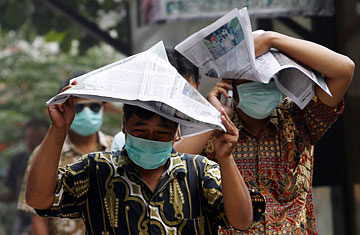
People protect themselves from volcanic ash after Mount Merapi's eruption in Yogyakarta, Indonesia, on Nov. 5, 2010
When the plates started shaking in his kitchen and the lamps in his house began to sway late Thursday night, Budi Santoso knew another explosion was on the way. Even though he lives 20 miles (32 km) away from Mount Merapi in central Java, he could feel the rumbling under his feet as if the giant volcano was just next door.
Just after midnight on Friday morning, Merapi exploded again, sending heat clouds and ash more than 4 miles (6.5 km) into the air. At least 49 people were killed in the blast, the ancient mountain's most violent eruption since 1872, when more than 1,400 people were killed. "It was pretty scary," recalls Budi. "Most of us are staying indoors and only going out if it is absolutely necessary."
More than 90 people have been killed since the legendary Indonesian volcano roared back to life on Oct. 25, disrupting travel to the popular tourist destination, much of which is now covered in ash and soot. Last week's eruption left 36 people dead near and on the slopes of the volcano. One of them was 83-year-old Mbah Maridjan, a man known as the volcano's spiritual gatekeeper. Residents brave enough to venture outdoors have been warned to wear masks and goggles, and there are now reports of ash drifting as far as west Java. The airport in Yogyakarta was still closed on Friday. "We have not been informed when the airports will reopen," says Kow Leong Kiang, a Malaysian who was supposed to be on a flight Friday morning back to his native Kuala Lumpur. "The air is very bad here, and we have been told it could damage our eyes and lungs if we are not careful."
Thousands of stranded travelers unable to wait around have been forced to drive as far as Surabaya, nearly 250 miles (400 km) away, to catch flights. Volcanic material in the air has also led hundreds to complain of respiratory problems following Friday's explosion.
Seismic activity in the country has been on the rise in the past two months, with about 20 other volcanoes across Indonesia also showing increased activity. The vast archipelago, situated on the highly volatile zone called the Ring of Fire, is struggling to deal with one natural disaster after another, from the Mentawai islands in the far west of the country, where 437 people were killed last week in a tsunami, to Wasior in the easternmost province of Papua, where 161 people were killed in early October in flash flooding and landslides.
Volcanologists are unable to say if Mount Merapi's activity has peaked or when the activity will possibly subside, but the government has evacuated more than 75,000 villagers living on the slopes of the mountain, and the thousands living in overcrowded shelters have not been told when they will be able to return home.
